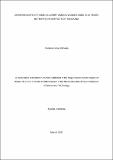| dc.description.abstract | Giving birth at health facilities in most of sub-Saharan African countries is still a challenge
whereby more than 51% of first-time mothers gives birth at home. In Tanzania more than
37% of women still give birth at home and among them 33% are below 20 years of age.
Studies on factors for home deliveries among women of reproductive age have been done in
Tanzania and the recommended interventions were kept in place. However due to the unique
needs of adolescent and young mothers there is a need of having current information on
determinants of home deliveries among women aged 15-24 years. The objective of this study
was to determine the factors of home deliveries among women aged 15-24 years in thirteen
districts of Tanzania. This was a mixed method study combining quantitative secondary data
analysis and qualitative primary data analysis. In secondary analysis we analyzed data
collected from October to November 2011. This involved woman aged 15-24 years who gave
birth one-year prior data collection in thirteen districts of Tanzania. In qualitative methods,
we analyzed data from health care providers’ key informants, and traditional birth attendants
(TBA). Data were collected from February to April 2019 in Bagamoyo, Tandahimba, Magu,
and Moshi Rural districts. The in-depth interviews from health care providers were based on
antenatal care (ANC) delivery and postnatal care (PNC) utilization among women aged 15-24
years. Traditional Birth Attendants were asked if they still conduct home deliveries, reasons
why women prefer to give birth at home and challenges they face during home delivery. A
total of 409 adolescents and young women who delivered in one-year prior to data collection
were included in the final analysis. A quarter of them give birth at home. Having at least four
ANC visits (OR=0.23, 95% CI: 0.12-0.41, p<0.01 ref: never attended), planning place of
delivery (OR=0.22, 95%CI: 0.14-0.36 P<0.01) and knowledge about the dangers signs during
pregnancy (OR=0.36, 95% CI: 0.22-0.57, P<0.01) were significantly associated with the
place of delivery. The study findings revealed that maternal educational, number of ANC
visits, planned place of delivery and knowledge about pregnant danger signs were
determinants associated with place of delivery among the women aged 15-24 years. It is
important to consider these factors in programming of interventions to reduce maternal
deaths. | en_US |


